Beixiong Zheng
Rotatable Antenna-Enabled Secure Wireless Communication
Apr 15, 2025Abstract:Rotatable antenna (RA) is a promising technology that exploits new spatial degrees of freedom (DoFs) to improve wireless communication and sensing performance. In this letter, we investigate an RA-enabled secure communication system where confidential information is transmitted from an RA-based access point (AP) to a single-antenna legitimate user in the presence of multiple eavesdroppers. We aim to maximize the achievable secrecy rate by jointly optimizing the transmit beamforming and the deflection angles of all RAs. Accordingly, we propose an efficient alternating optimization (AO) algorithm to obtain a high-quality suboptimal solution in an iterative manner, where the generalized Rayleigh quotient-based beamforming is applied and the RAs' deflection angles are optimized by the successive convex approximation (SCA). Simulation results show that the proposed RA-enabled secure communication system achieves significant improvement in achievable secrecy rate as compared to various benchmark schemes.
Rotatable Antennas for Integrated Sensing and Communications
Mar 13, 2025Abstract:In this letter, we propose to deploy rotatable antennas (RAs) at the base station (BS) to enhance both communication and sensing (C&S) performances, by exploiting a new spatial degree-of-freedom (DoF) offered by array rotation. Specifically, we formulate a multi-objective optimization problem to simultaneously maximize the sum-rate of multiple communication users and minimize the Cram\'er-Rao bound (CRB) for target angle estimation, by jointly optimizing the transmit beamforming vectors and the array rotation angle at the BS. To solve this problem, we first equivalently decompose it into two subproblems, corresponding to an inner problem for beamforming optimization and an outer problem for array rotation optimization. Although these two subproblems are non-convex, we obtain their high-quality solutions by applying the block coordinate descent (BCD) technique and one-dimensional exhaustive search, respectively. Moreover, we show that for the communication-only case, RAs provide an additional rotation gain to improve communication performance; while for the sensing-only case, the equivalent spatial aperture can be enlarged by RAs for achieving higher sensing accuracy. Finally, numerical results are presented to showcase the performance gains of RAs over fixed-rotation antennas in integrated sensing and communications (ISAC).
Linear Model of RIS-Aided High-Mobility Communication System
Feb 28, 2025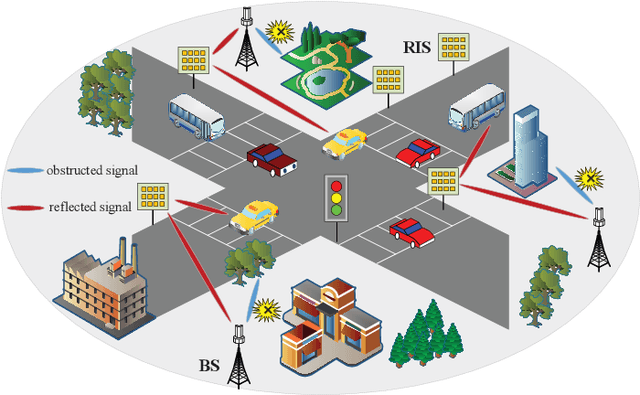



Abstract:Reconfigurable intelligent surface (RIS)-aided vehicle-to-everything (V2X) communication has emerged as a crucial solution for providing reliable data services to vehicles on the road. However, in delay-sensitive or high-mobility communications, the rapid movement of vehicles can lead to random scattering in the environment and time-selective fading in the channel. In view of this, we investigate in this paper an innovative linear model with low-complexity transmitter signal design and receiver detection methods, which boost stability in fast-fading environments and reduce channel training overhead. Specifically, considering the differences in hardware design and signal processing at the receiving end between uplink and downlink communication systems, distinct solutions are proposed. Accordingly, we first integrate the Rician channel introduced by the RIS with the corresponding signal processing algorithms to model the RIS-aided downlink communication system as a Doppler-robust linear model. Inspired by this property, we design a precoding scheme based on the linear model to reduce the complexity of precoding. Then, by leveraging the linear model and the large-scale antenna array at the base station (BS) side, we improve the linear model for the uplink communication system and derive its asymptotic performance in closed-form. Simulation results demonstrate the performance advantages of the proposed RIS-aided high-mobility communication system compared to other benchmark schemes.
* accepted in IEEE Transactions on Vehicular Technology( Early Access )
Joint Size and Placement Optimization for IRS-Aided Communications with Active and Passive Elements
Feb 24, 2025Abstract:Different types of intelligent reflecting surfaces (IRS) are exploited for assisting wireless communications. The joint use of passive IRS (PIRS) and active IRS (AIRS) emerges as a promising solution owing to their complementary advantages. They can be integrated into a single hybrid active-passive IRS (HIRS) or deployed in a distributed manner, which poses challenges in determining the IRS element allocation and placement for rate maximization. In this paper, we investigate the capacity of an IRS-aided wireless communication system with both active and passive elements. Specifically, we consider three deployment schemes: 1) base station (BS)-HIRS-user (BHU); 2) BS-AIRS-PIRS-user (BAPU); 3) BS-PIRS-AIRS-user (BPAU). Under the line-of-sight channel model, we formulate a rate maximization problem via a joint optimization of the IRS element allocation and placement. We first derive the optimized number of active and passive elements for BHU, BAPU, and BPAU schemes, respectively. Then, low-complexity HIRS/AIRS placement strategies are provided. To obtain more insights, we characterize the system capacity scaling orders for the three schemes with respect to the large total number of IRS elements, amplification power budget, and BS transmit power. Finally, simulation results are presented to validate our theoretical findings and show the performance difference among the BHU, BAPU, and BPAU schemes with the proposed joint design under various system setups.
Rotatable Antenna Enabled Wireless Communication: Modeling and Optimization
Jan 07, 2025



Abstract:Fluid antenna system (FAS) and movable antenna (MA) have recently emerged as promising technologies to exploit new spatial degrees of freedom (DoFs), which have attracted growing attention in wireless communication. In this paper, we propose a new rotatable antenna (RA) model to improve the performance of wireless communication systems. Different from conventional fixed antennas, the proposed RA system can flexibly alter the three-dimensional (3D) boresight direction of each antenna independently by adjusting its deflection angles to achieve a desired array directional gain pattern. Specifically, we investigate an RA-enabled uplink communication system, where the receive beamforming and the deflection angles of all RAs at the base station (BS) are jointly optimized to maximize the minimum signal-to-interference-plus-noise ratio (SINR) among all the users. In the special single-user and free-space propagation setup, the optimal deflection angles of RAs are derived in closed form with the maximum-ratio combining (MRC) beamformer applied at the BS. Moreover, we analyze the asymptotic performance with an infinite number of antennas based on this solution, which theoretically proves that the RA system can achieve a higher array gain as compared to the fixed-antenna system. In the general multi-user and multi-path channel setup, we first propose an alternating optimization (AO) algorithm to alternately optimize the receive beamforming and the deflection angles of RAs in an iterative manner. Then, a two-stage algorithm that solves the formulated problem without the need for iteration is further proposed to reduce computational complexity. Simulation results are provided to validate our analytical results and demonstrate that the proposed RA system can significantly outperform other benchmark schemes.
Passive Six-Dimensional Movable Antenna (6DMA)-Assisted Multiuser Communication
Dec 06, 2024


Abstract:Six-dimensional movable antenna (6DMA) is a promising solution for enhancing wireless network capacity through the adjustment of both three-dimensional (3D) positions and 3D rotations of distributed antenna surfaces. Previous works mainly consider 6DMA surfaces composed of active antenna elements, thus termed as active 6DMA. In this letter, we propose a new passive 6DMA system consisting of distributed passive intelligent reflecting surfaces (IRSs) that can be adjusted in terms of 3D position and 3D rotation. Specifically, we study a passive 6DMA-aided multiuser uplink system and aim to maximize the users' achievable sum rate by jointly optimizing the 3D positions, 3D rotations, and reflection coefficients of all passive 6DMA surfaces, as well as the receive beamforming matrix at the base station (BS). To solve this challenging non-convex optimization problem, we propose an alternating optimization (AO) algorithm that decomposes it into three subproblems and solves them alternately in an iterative manner. Numerical results are presented to investigate the performance of the proposed passive 6DMA system under different configurations and demonstrate its superior performance over the traditional fixed-IRS counterpart for both directive and isotropic radiation patterns of passive reflecting elements.
6DMA-Aided Cell-Free Massive MIMO Communication
Dec 02, 2024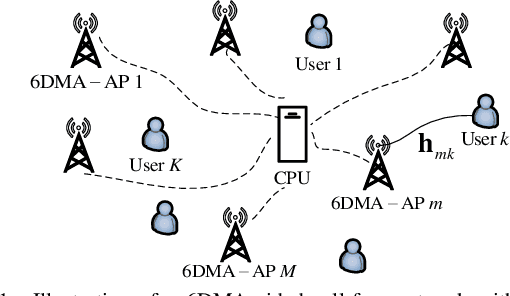
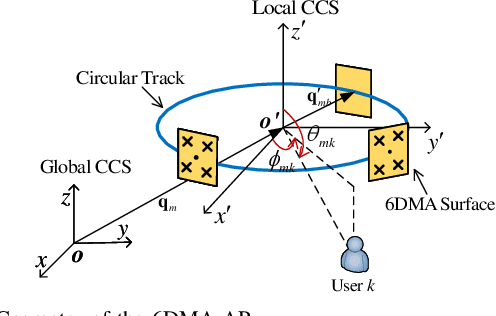
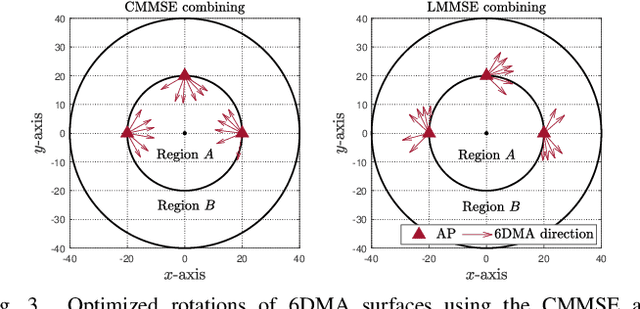
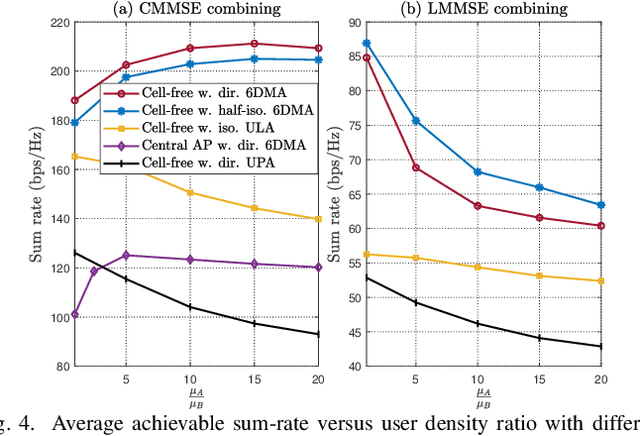
Abstract:In this letter, we propose a six-dimensional movable antenna (6DMA)-aided cell-free massive multiple-input multiple-output (MIMO) system to fully exploit its macro spatial diversity, where a set of distributed access points (APs), each equipped with multiple 6DMA surfaces, cooperatively serve all users in a given area. Connected to a central processing unit (CPU) via fronthaul links, 6DMA-APs can optimize their combining vectors for decoding the users' information based on either local channel state information (CSI) or global CSI shared among them. We aim to maximize the average achievable sum-rate via jointly optimizing the rotation angles of all 6DMA surfaces at all APs, based on the users' spatial distribution. Since the formulated problem is non-convex and highly non-linear, we propose a Bayesian optimization-based algorithm to solve it efficiently. Simulation results show that, by enhancing signal power and mitigating interference through reduced channel cross-correlation among users, 6DMA-APs with optimized rotations can significantly improve the average sum-rate, as compared to the conventional cell-free network with fixed-position antennas and that with only a single centralized AP with optimally rotated 6DMAs, especially when the user distribution is more spatially diverse.
Modeling and Optimization for Rotatable Antenna Enabled Wireless Communication
Nov 14, 2024

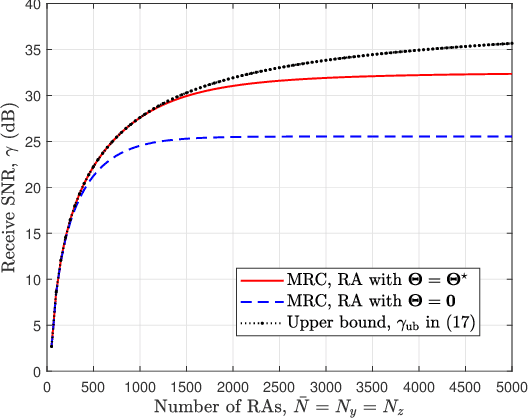

Abstract:Fluid antenna system (FAS)/movable antenna (MA) has emerged as a promising technology to fully exploit the spatial degrees of freedom (DoFs). In this paper, we propose a new rotatable antenna (RA) model, as a simplified implementation of six-dimensional movable antenna (6DMA), to improve the performance of wireless communication systems. Different from conventional fixed-position antenna (FPA), the proposed RA system can independently and flexibly change the three-dimensional (3D) orientation of each antenna by adjusting its declination angles to achieve desired channel realizations. Specifically, we study an RA-enabled uplink communication system, where the receive beamforming and the declination angles of all RAs are jointly optimized to maximize the minimum signal-to-interference-plus-noise ratio (SINR) among all the users. In the special single-user and free-space propagation setup, the optimal declination angles are derived in closed form with the maximum-ratio combining (MRC) beamformer applied at the base station (BS). In the general multi-user and multi-path setup, we propose an alternating optimization (AO) algorithm to alternately optimize the receive beamforming and the declination angles in an iterative manner. Simulation results are provided to demonstrate that the proposed RA-enabled system can significantly outperform other benchmark schemes.
Channel Estimation for XL-IRS Assisted Wireless Systems with Double-sided Visibility Regions
Aug 30, 2024



Abstract:In this paper, we study efficient channel estimation design for an extremely large-scale intelligent reflecting surface (XL-IRS) assisted multi-user communication systems, where both the base station (BS) and users are located in the near-field region of the XL-IRS. Two unique channel characteristics of XL-IRS are considered, namely, the near-field spherical wavefronts and double-sided visibility regions (VRs) at the BS and users, which render the channel estimation for XL-IRS highly challenging. To address this issue, we propose in this paper an efficient three-step XL-IRS channel estimation method. Specifically, in the first step, an anchor node is delicately deployed near the XL-IRS to estimate the cascaded BS-IRS-anchor channel. Then, an efficient VR detection method is devised to estimate the VR information between the BS and XL-IRS. In this way, only the channels from the visible XL-IRS elements to the BS are estimated, thereby reducing the dimension of the cascaded BS-IRS-users channels to be estimated. Third, by leveraging the common BS-IRS channel, the cascaded channels for all users are consecutively estimated accounting for the VRs of the IRS-user channels. Finally, numerical results are provided to demonstrate the effectiveness of our proposed channel estimation scheme as compared to various benchmark schemes.
Intelligent Reflecting Surface-Aided Radar Spoofing
May 11, 2024Abstract:Electronic countermeasure (ECM) technology plays a critical role in modern electronic warfare, which can interfere with enemy radar detection systems by noise or deceptive signals. However, the conventional active jamming strategy incurs additional hardware and power costs and has the potential threat of exposing the target itself. To tackle the above challenges, we propose a new intelligent reflecting surface (IRS)-aided radar spoofing strategy in this letter, where IRS is deployed on the surface of a target to help eliminate the signals reflected towards the hostile radar to shield the target, while simultaneously redirecting its reflected signal towards a surrounding clutter to generate deceptive angle-of-arrival (AoA) sensing information for the radar. We optimize the IRS's reflection to maximize the received signal power at the radar from the direction of the selected clutter subject to the constraint that its received power from the direction of the target is lower than a given detection threshold. We first solve this non-convex optimization problem using the semidefinite relaxation (SDR) method and further propose a lower-complexity solution for real-time implementation. Simulation results validate the efficacy of our proposed IRS-aided spoofing system as compared to various benchmark schemes.
 Add to Chrome
Add to Chrome Add to Firefox
Add to Firefox Add to Edge
Add to Edge